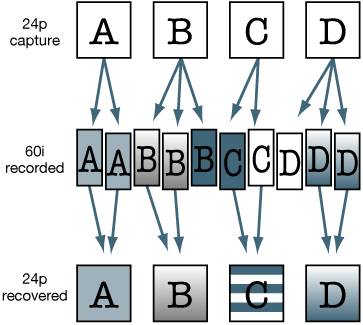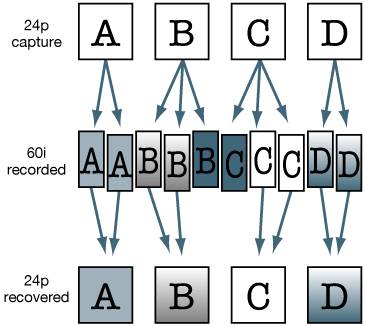24p
| Film is normally shown at 24 frames per second, which doesn't fit nicely into either the NTSC nor the PAL scheme of things, yet film is often shown on television, and there are now cameras shooting 24p (24 frames per second, progressively scanned) on tape. NTSC transfers use a 3:2 pulldown or 2:3 pulldown process to convert 24 frames of film to 60 fields of video. The film is run at 23.98 fps, slowed one part in a thousand to match NTSC rates. The first film frame (the "A frame") is recorded to two fields of video. The second (B) frame is recorded to three fields. The third, or C, frame is recorded to two fields again, but since the B frame introduced an extra field, the C frame is recorded to the second field of one frame and the first of another. The D frame is again recorded to three fields, for a total of 10 fields or 5 full video frames for the four original film frames. This four-frame cadence is repeated a total of six times per second, converting 24 frames of film to 60 fields (30 frames) of video. Several standard-definition video cameras can perform the same pulldown, converting film-like 24 fps images into 60i video for recording on tape. However, this cadence splits the C frame across two different video frames, making clean extraction of the original 24 fps material difficult: two different video frames need to be decompressed to recover the C frame. Panasonic developed an alternative cadence they call "24p Advanced" for the DVX100, DVX100A, and SDX900 cameras, syncopating the rhythm slightly for a 2:3:3:2 pulldown. As you might guess from the name, the A and D frames are recorded for two fields and the B and C frames are recorded thrice. The resulting video is slightly less smooth than normal 24p when playing back as 60i video, but the C frame can be recovered from a single video frame, without having to decompress two different frames and steal a field from each. The Canon XL2 camera also offers a 2:3:3:2 pulldown in its 24p mode. 24p Advanced 2:3:3:2 Pulldown You can capture 2:3:3:2 pulldown in FCP over FireWire with the pulldown removed in real time, resulting in 20 percent smaller files playing at a 23.98 fps rate. FCP can also remove advanced pulldown after the fact if such clips were captured at 29.97. 29.97 clips using 2:3 pulldown, whether shot in camera or transferred from film, can be converted to 23.98 clips using Cinema Tools. Tip If you have captured 24p clips at 29.97, you can tell 2:3 clips from 2:3:3:2 clips by single-stepping through them in FCP while monitoring the FireWire output, or by setting the Viewer or Canvas to 100%, with the Show As Sq. Pixels setting turned off. If you see two interlaced frames in every five, the clip uses 2:3 pulldown. If you see only one, it uses 2:3:3:2 pulldown. Note Two short 24p DV clips are available in the lesson directory: 24p.mov and 24pa.mov. You can experiment with them in FCP and in Cinema Tools. More Info For information on how 24p is recorded and how to deal with it in postproduction, go to www.adamwilt.com/24p/. In the PAL-compatible world, film is normally sped up 4 percent to 25 fps, and transferred to tape frame-for-frame: a 1:1 pulldown. There is no fancy cadence to worry about, and every frame on tape matches a frame of film. Indeed, film shot for television in the PAL world has long been shot at 25 fps to begin with, so no speed changes (with accompanying pitch shifts in the audio) need to be accommodated. PAL-format camcorders with "film-like" shooting modes likewise skip any attempt at recording 24p and simply record 25p. Before the advent of 24p-capable NTSC-compatible camcorders, many digital filmmakers shot with PAL cameraseven in interlaced modeto get the higher vertical resolution of the PAL frame and the easier transfer to film that the 1:1 pulldown factor provides. Even today, it's not always an easy choice to go with a 480-line 24p camera that transfers at normal speed instead of a 576-line 25p camera that requires a 4 percent speed change when printing out to film. |
EAN: N/A
Pages: 205

